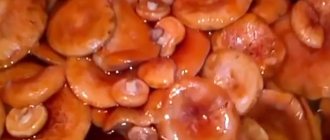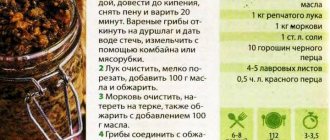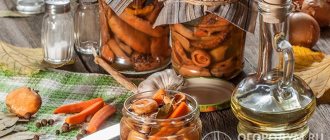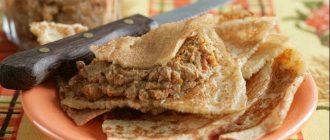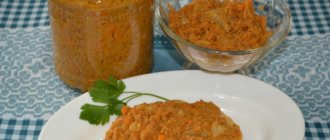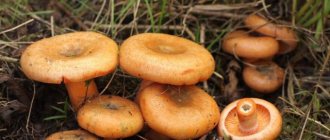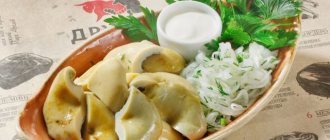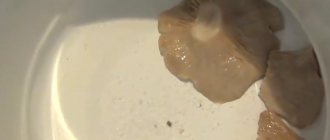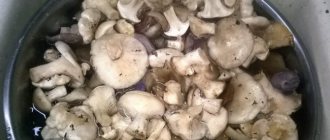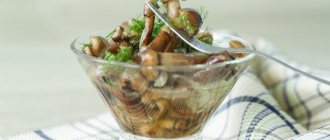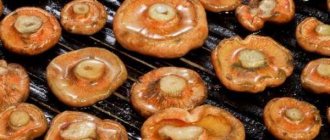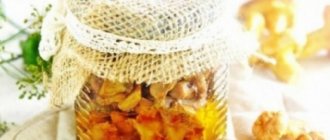Continuing the theme of mushrooms and preparing them for the winter, today I propose to replenish your home supplies with salted saffron milk caps.
These mushrooms turn out very tasty, crispy and aromatic. They are so great to put on the table in winter along with boiled potatoes. Your guests will also love this mushroom appetizer. Salted saffron milk caps will help you out more than once when preparing a quick dinner or serving an appetizer on a holiday table.
All recipes are easy to prepare; mushrooms completely retain their appearance and hardly change color if they are salted correctly. Moreover, they look very joyful on the table, attracting all eaters with their appetizing appearance.
In addition, saffron milk caps are incredibly healthy; it is not for nothing that their nutritional properties are compared to porcini mushrooms. In terms of protein content, they are comparable to meat, poultry and fish. In addition, they are well absorbed by the body.
How to pickle saffron milk caps using the cold method. Simple recipe
Pickling saffron milk caps does not involve heat treatment, which allows the mushrooms to retain their beautiful bright color. The method used here is called cold. Everything is done simply and quickly; you will need an enamel pan in which to salt them.
Ingredients:
- saffron milk mushrooms - any quantity
- salt - 1 tbsp. l. (with a large slide) for 1 kg of mushrooms
- horseradish leaves - optional
- dill umbrellas - optional
- After clearing the saffron milk caps from forest debris and rinsing them under running water, you should cut off the end of the stem with the ground. Remove wormy specimens. If you hate to throw them away, then soak them in cold salted water for 10 minutes (1 tablespoon of salt per liter). All living creatures will crawl out of them. Then rinse through a sieve to drain all the water. If you collected saffron milk caps in dry weather and they are clean, you don’t need to wash them. This will be the so-called dry pickling method, where the mushrooms do not come into contact with water.
- Now we will place the prepared mushrooms in the pan. You can put fresh horseradish leaves on the bottom, which will protect against mold. In our family, we always salt these mushrooms without adding herbs and spices, since we believe that saffron milk caps are self-sufficient and fully retain their taste when salted.
Layer the mushrooms and sprinkle them with salt. Here you can put dill sprigs, bay leaves, oak leaves, and a sprig of wild rosemary between the layers, if you see fit. - When the pan is full, add salt to the top layer. Experienced mushroom pickers say that if you put a green fern leaf on top of the pickling, then mold is not a problem. Ferns don’t grow in our forest, so I didn’t check. Write in the comments, it will be interesting to see how you do.
- Cover with an inverted plate and place pressure on top, for example, in the form of a jar filled with water. You can also weigh the plate down with a cobblestone. It is important that the pressure be heavy so that the mushrooms give juice. It is in it that they will be salted.
- We take it out into the cold, you can put it on a shelf in the refrigerator. We stand for 2 weeks. And then you can leave the appetizer in the pan or put it in dry jars along with the brine. It will be more convenient for you. The mushrooms should be kept for another 2 weeks. It turns out that after a month you can take the first sample. This is when the mushrooms become most fragrant.
Video
We offer you a few more video recipes for cold pickling of saffron milk caps:
https://youtube.com/watch?v=%2520%E2%80%B3%26gt%3B
Freelancer with diverse interests and hobbies. Likes to be close to nature, eat delicious food and philosophize about the eternal. She has been writing articles on a variety of topics for so long that she is already erudite in the most unexpected areas. Loves forests, flowering gardens, space and fried potatoes with smoked ribs. He doesn’t like to stand at the stove, but among his friends there are several professional chefs who will always feed you delicious food and share cool recipes. Pathologically optimistic.
Found a mistake? Select the text with the mouse and click:
One of the most convenient methods for preparing a harvest of vegetables, fruits and berries is freezing. Some believe that freezing causes the nutritional and health benefits of plant foods to be lost. As a result of the research, scientists have found that there is practically no decrease in nutritional value when frozen.
Humus is rotted manure or bird droppings. It is prepared like this: the manure is piled up in a heap or pile, layered with sawdust, peat and garden soil. The pile is covered with film to stabilize temperature and humidity (this is necessary to increase the activity of microorganisms). The fertilizer “ripens” within 2-5 years, depending on external conditions and the composition of the feedstock. The output is a loose, homogeneous mass with a pleasant smell of fresh earth.
Natural toxins are found in many plants; Those grown in gardens and vegetable gardens are no exception. Thus, the seeds of apples, apricots, and peaches contain hydrocyanic acid, and the tops and peels of unripe nightshades (potatoes, eggplants, tomatoes) contain solanine. But do not be afraid: their number is too small.
You need to collect medicinal flowers and inflorescences at the very beginning of the flowering period, when the content of nutrients in them is highest. Flowers are supposed to be picked by hand, tearing off the rough stalks. Dry the collected flowers and herbs, scattered in a thin layer, in a cool room at natural temperature without access to direct sunlight.
Top articles: How to keep lemon from drying out at home
“Frost-resistant” varieties of garden strawberries (more often simply “strawberries”) need shelter just as much as ordinary varieties (especially in those regions where there are snowless winters or frosts alternating with thaws). All strawberries have superficial roots. This means that without shelter they freeze to death. Sellers’ assurances that strawberries are “frost-resistant,” “winter-hardy,” “tolerates frosts down to −35 ℃,” etc. are deception. Gardeners must remember that no one has yet managed to change the root system of strawberries.
Tomatoes have no natural protection against late blight. If late blight attacks, any tomatoes (and potatoes too) die, no matter what is said in the description of the varieties (“variety resistant to late blight” is just a marketing ploy).
In Australia, scientists have begun experiments in cloning several varieties of grapes grown in cold regions. Climate warming, which is predicted for the next 50 years, will lead to their disappearance. Australian varieties have excellent characteristics for winemaking and are not susceptible to diseases common in Europe and America.
In little Denmark, any piece of land is a very expensive pleasure. Therefore, local gardeners have adapted to growing fresh vegetables in buckets, large bags, and foam boxes filled with a special earthen mixture. Such agrotechnical methods make it possible to obtain a harvest even at home.
From varietal tomatoes you can get “your own” seeds for sowing next year (if you really like the variety). But it is useless to do this with hybrids: you will get seeds, but they will carry the hereditary material not of the plant from which they were taken, but of its numerous “ancestors”.
Collecting and pickling saffron milk mushrooms for the winter is the task of all self-respecting mushroom pickers. Moreover, you need to do it correctly so that they are crispy, aromatic, and tasty. There are two main recipes for preparing mushrooms with red caps at home: cold or hot. They are easy to implement, have been tested for a long time, and never fail.
It seems as if the mushrooms inherited their bright, red caps from fairy-tale gnomes. In jars they look elegant and appetizing.
Hot pickling of saffron milk caps for the winter is very tasty and always successful
Salting of saffron milk caps can be done not only cold, but also hot. In this case, the mushrooms are pre-boiled and salted along with sliced garlic cloves, dill seeds, mustard seeds and bay leaves. After a month, you get an incredibly tasty snack.
The mushrooms can be placed on a serving dish, seasoned with vegetable oil and chopped onion rings, or seasoned with sour cream. It’s hard to think of anything tastier than a snack!
Ingredients:
- dill seeds or dill umbrellas - optional
- We sort the mushrooms, remove debris and cut off the stems from the ground. You can cut large caps into 2-4 pieces, and leave small ones as is. Rinse with running water and drain in a colander.
- Transfer the saffron milk caps to a cooking pot and fill with water.
- Bring to a boil. Cook for 5 minutes over medium heat, constantly skimming off the foam.
- Then place the mushrooms in a colander to drain the water completely.
- In an enamel basin, wooden boat, glass container or plastic container, we will lay out the mushroom caps in layers so that the plate part is facing up.
- After laying out the layer, salt it with a good pinch of coarse salt. Don’t be afraid to over-salt the mushrooms; this won’t happen with saffron milk caps. Scatter slices of garlic, caraway seeds (aka dill seeds) and a couple of bay leaves, crushed in your hands. We do this until the mushrooms run out.
By the way, if in another 2-3 days you collect new saffron milk caps, you can also add them to the same salting process.
- Cover the mushrooms with gauze folded several times and press with any pressure. We send it to salt in the refrigerator for 3-4 weeks.
Preservation storage rules
During preparation, all sterilization standards must be strictly observed. A hermetically sealed jar can be stored at room temperature in the pantry
It is important that there is no boiler, radiator, stove or stove nearby. Heat stimulates the growth of microbes and will cause product spoilage
Mushrooms must not be stored for longer than 2 years.
It is better to consume in its pure form within one year; It is important to heat the preparations that remain after opening: frying, boiling, stewing. Keep salted saffron milk caps in a cool room, it is better if there is no direct sunlight.
If the storage temperature is above 5 degrees, this will lead to spoilage of the mushrooms.
In ancient times, wooden tubs were used to pickle mushrooms. Wood is an environmentally friendly material. If you don’t have such a tub, a glass container will do. After pickling, store mushrooms for six months. Pickled mushrooms are stored in the basement or cellar.
The best recipe for pickling saffron milk caps for the winter in glass jars
If you want to prepare mushrooms for long-term storage in an ordinary apartment, pay attention to this recipe. Here saffron milk caps are prepared hot, i.e. boiled. Separately, the brine is boiled with spices and poured over the mushrooms.
Ingredients:
- freshly picked saffron milk caps - any quantity
for 1.5 liters of brine:
- 1.5 l - water
- 8-10 pcs. - black and allspice peas
- 4 pcs. - cloves and bay leaf
- 1 stick - cinnamon
- 1 tbsp. l. - regular salt
- We will sort out the mushrooms, removing the stems, soil and any debris. Wash with running water and let the water drain through a colander.
- Let's put the jars to sterilize. An oven heated to 100 degrees is used here.
- Fill the pan with mushrooms with water and place on the stove. After boiling, cook the saffron milk caps for a short time - 10 minutes. Remove from heat and place them on a sieve.
- Let's put the brine to boil. Pour the required amount of water, add salt and spices. Cook after boiling for 5 minutes.
- Place the mushrooms in the spicy brine, bring to a boil and cook for another 10 minutes. Turn off the heat and place the saffron milk caps in jars along with the brine to the very top. Screw on the boiled lids and turn them upside down, checking for leaks.
General description of the species
Saffron milk caps (in Latin Lactarius deliciosus, i.e. “delicious milkweed”) are edible mushrooms of the genus Lactarius, the Russula family.
Camelina usually grows in groups in spruce and pine forests. The mushroom cap, initially convex, straightens as it grows and becomes funnel-shaped with curled edges, shiny, smooth, from four to fifteen centimeters in diameter. The color is orange with concentric circles of a darker shade. The plates are thin, bifurcated, and frequent. The leg is smooth, cylindrical in shape, slightly tapering towards the base. The pulp is elastic, dense, yellow-orange in color. The collection season is from mid-July to the end of September.
Video about how to quickly and easily pickle saffron milk caps at home
I would like to introduce you to another super quick way to pickle saffron milk caps, when you can eat the mushrooms in just four days. Although there are ways to salt even faster - literally in 2 hours. Some mushroom pickers believe that saffron milk caps can be eaten almost raw, but personally I would not dare to try such an appetizer. Therefore, I offer you this option, it is simple and quick, and the mushrooms turn out very tasty. At the beginning of the video, the author filmed him collecting saffron milk caps in the forest. It will be interesting to see for those who are not yet familiar with these wonderful gifts of the forest.
Today you learned the most common ways to prepare saffron milk caps for the winter. These mushrooms are very tasty and healthy, which is why many people like to collect them in the forest and make home supplies. I would be glad if you use this selection and add another successful snack to your shelves.
Friends, I’m always glad to see you on the pages of my blog, write comments, vote with stars, share your favorite materials with your friends by clicking on the social buttons, bookmark interesting recipes so as not to lose them. Best regards, Love.
Selection and preparation of ingredients
To ensure that salted saffron milk caps prepared for the winter always turn out tasty and have a good appearance, you need to choose them well and prepare them correctly. The main ingredient can be collected in the forest yourself or bought in a store.
The antibiotic lactarioviolin, known in medicine, which suppresses the activity of many harmful bacteria, was synthesized from the pulp of camelina mushrooms.
When selecting and preparing mushrooms for pickling, you must follow the recipe and observe the following conditions:
- You only need to salt fresh mushrooms with a smooth and elastic surface, without rot;
- It is better not to use the legs of saffron milk caps for pickling - they often contain worms;
- the product must be washed under running water, cleaning the surface of the fruiting bodies from a lot of dirt and debris using a sponge;
- It is recommended to pickle the mushrooms whole, but large specimens can be cut into several small pieces.
We recommend that you familiarize yourself with: pickling boletuses, oyster mushrooms and honey mushrooms.
Recipe No. 1
easily
